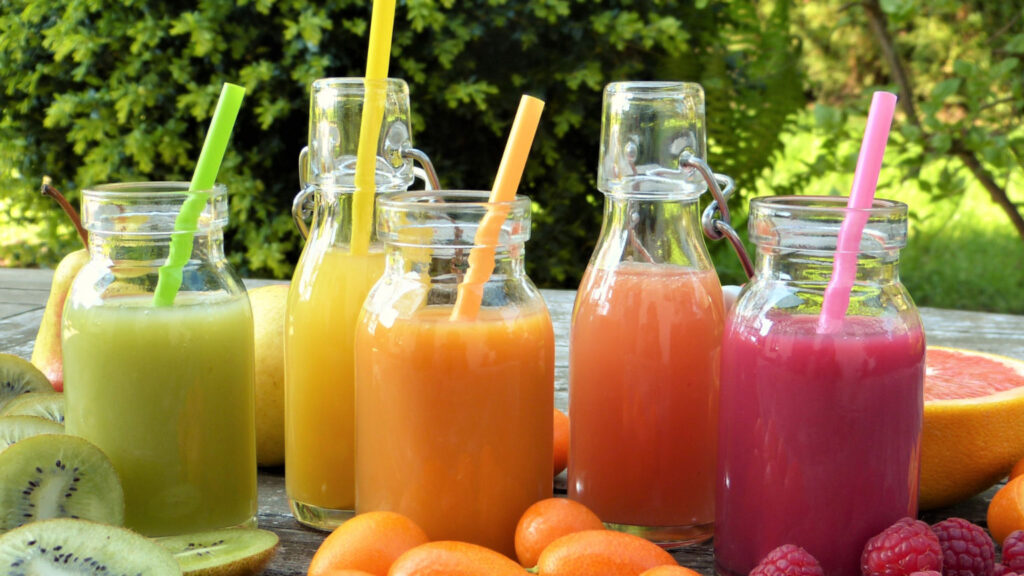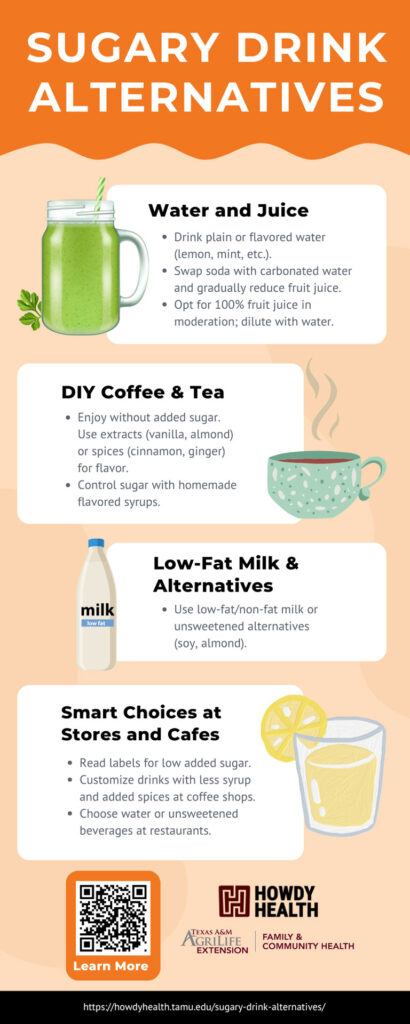Alternatives for Reducing Added Sugar Intake
So, what can you do to reduce your added sugar intake in these categories? Find a myriad of ideas here – some with no added sugar and others to help you reduce the added sugar in the beverages you already enjoy. We have provided 5 ways to replace your sugar-sweetened beverages with healthier alternatives.
- Select water, carbonated water, and 100% fruit juice
- Brew your own variety of coffee and tea
- Chose low-fat milk and milk alternatives
- Replace energy drinks with healthier options
- Make smart choices at the grocery store, restaurant, and coffee shop
1. Select Water, Carbonated Water, and Juice
- Drink plain water. Water is the #1 recommended beverage that has zero-sugar and zero-calories.
- Flavor your water with fresh fruit, a small amount of 100% fruit juice, and/or herbs. The longer you leave fresh fruit, the stronger it will taste. You can also squeeze or muddle them in the water to give it a bit more flavor. Try these combinations:
- Fresh lemon juice and sliced strawberries
- Watermelon and mint leaves
- Peach and ginger
- Turmeric powder and fresh lemon juice (try this one in warm water).2
- Swap soda for carbonated water. As with plain water, you can flavor carbonated water with Fresh fruit, 100% fruit juice, and/or herbs. If you’re trying to move from soda to carbonated water, start with a 1:1 ratio (half carbonated water and half 100% fruit juice). Gradually, use less juice and more carbonated water until you just need a splash of juice. Try these combinations:
- Fresh mint, cucumber slices, and a squeeze of lime
- Squeeze of fresh orange juice.
- Raspberry and fresh lime juice.
- Opt for 100% fruit juice – in moderation – over soda or other fruit drinks. Keep in mind that a cup (yes, an actual measuring cup or 8 ounces) of 100% orange juice has 23 grams of (natural) sugar – almost four teaspoons. So, if you’re low on fruit consumption for the day, that might be ok, but it’s best to have it in moderation – or better yet – eat whole fruit, which also provides fiber (which digests more slowly and can help you feel fuller, longer) and other beneficial nutrients.3
- Dilute 100% fruit juice with water gradually to reduce added sugar intake. Try these options:
- Mix ½ cup apple juice with ½ cup water and a splash of lemon juice.
- Mix 1/3 cup orange juice with 3 cups water
- Mix ¼ cup cherry juice with 2 cups water and a squeeze of lime.
- Choose a smoothie but keep portion size in mind. Blending fresh, frozen, or canned fruits (make sure they’re canned in their own juices or in water – not syrup) can be a great way to add some nutrients to your day, but it can be easy to overdo it. Start with lots of crushed ice to keep the sugar content lower. Use lower sugar content fruits, such as:
- Apples
- Apricots
- Avocado
- Berries (blackberries, blueberries, cranberries, raspberries, strawberries, etc.)
- Cantaloupe
- Clementines
- Grapefruit
- Honeydew melon
- Kiwi
- Nectarines
- Oranges
- Papaya
- Peaches
2. Brew Your Own Variety of Coffee and Tea
- Enjoy coffee and tea without added sugar, either hot or iced.
- Enhance flavor with extracts like almond, coconut, peppermint, or vanilla.
- Add spices like cinnamon, cardamom, ginger, or nutmeg for natural sweetness.
- Pour in a splash of milk (or unsweetened milk alternative) for creaminess. Whisk or froth milk for on top.
- Control sugar by purchasing your own flavored syrups and using them sparingly. (Remember, you can almost always better control sugar content by buying unsweetened and adding your own portion-controlled sweetener. Just be sure you’re lessening the amount of sweetener you use, rather than adding to what you’re used to drinking.)
- Add unsweetened powders. Peanut butter-, protein-, or cocoa- powder are all fun options to try in coffee – hot or iced. (Note: Cocoa powder offers the bonus of flavonoids, which are antioxidants that can ward off damage to cells and improve blood flow to the brain and heart.)4,5
- Add a pinch of salt – what? Yes, a pinch of salt added to a pot of coffee or to the coffee grounds before brewing can actually help enhance the natural sweetness. Salt reduces bitterness, so the coffee will seem sweeter without adding sugar.5 For a full pot of coffee, simply add ¼ teaspoon kosher salt to 6 tablespoons of coffee grounds – just enough to reduce the bitterness and bring out the natural sweetness.5
Experiment with the following coffee and tea combinations for unique flavors.
Coffees:
- Try a caffè latte made with coffee, milk (or an unsweetened milk alternative), and a dash of cinnamon or nutmeg.
- Add steamed milk, a dash of cinnamon, and 1 teaspoon of peanut butter powder to your coffee for a sweet nutty flavor.
- Stir ½ teaspoon of cinnamon into your coffee (or stir a teaspoon into the grounds before brewing). Not only will you get added flavor, but cinnamon also comes with bonus health benefits (as an antioxidant and antimicrobial compound).6 Add a bit of cardamom for added interest.2,5
Teas:
- Add cinnamon, cardamom, and ginger to hot or cold chai tea. Add a splash of milk, if you like.
- Combine black tea with orange rind, cinnamon, and a slice of fresh orange.
- Steep your favorite hot tea with fresh mint, lemon, ginger, and fennel seed.
- Steam milk (or unsweetened milk alternative) and add it to Earl Grey tea with a drop of vanilla or almond extract.
- Try an apple cinnamon tea infused with fresh apple slices.
- Liven up mint tea with fresh ginger slices or ginger tea with a fresh sprig of mint.
- Try hot green tea with a squeeze of lemon or iced green tea steeped with fresh mint.
- Make an iced hibiscus tea mixed with frozen strawberries and blueberries.
- Try iced lemon, mint, or blueberry herbal tea with a splash of sparkling lime water.
- Create an iced matcha (Japanese green tea powder) with soy milk and crushed raspberries.2
3. Choose Low-Fat Milk and Milk Alternatives
- Choose low-fat or non-fat milk, which will provide key nutrients without added sugar. For extra flavor add a drop of vanilla, coconut, or almond extract.
- Try an unsweetened milk alternative like soy, almond, or oat milk. (Soy milk has the closest nutrient profile to cow’s milk.) Try plain or flavored varieties (e.g., vanilla almond milk), just be sure the milk alternative is unsweetened.
- Create a milk latte. Heat milk and add a bit of unsweetened cocoa, peanut butter powder, or matcha powder.2
- Create a mock-milkshake by combining cold milk with unsweetened cocoa-, protein-, or peanut butter- powder (with no added sugar). Add ice and shake or blend until ice is crushed. Place in the freezer for 10-15 minutes to firm it up a bit.
- Feeling adventurous? Try ice cold buttermilk infused with cumin and fresh mint.2
4. Replace Energy Drinks with Healthier Options
Though energy drinks are frequently marketed as products that increase energy, they often have added sugar, large amounts of caffeine, and other legal stimulants. Concerns have also been raised about potential health risks.7
If you’re looking for a quick pick-me-up and normally reach for an energy drink, experiment with these options:
- Consider your hydration level. Have you had enough water or water-based fruits and veggies today? Dehydration is often a reason for low energy.8
- Choose hot or iced coffee or tea. A number of tea flavors are available in naturally caffeinated varieties.9
- Try something a bit more substantial, like a serving of 100% fruit or vegetable juice, a small smoothie (keep portion size in mind), or a piece of whole fruit, because sometimes a snack can give you as much of a boost as a drink.7
5. Make Smart Choices at the Grocery Store, Restaurant, and Coffee Shop
- At the grocery store, read the Nutrition Facts Labels. Consider the myriad of flavored water, including carbonated waters. If any have added sugars, make sure they have 5% Daily Value (DV) or less, which is considered a lower level of added sugar. If they aren’t sweet enough, it would still be better to bring them home and add your own small amount of sugar, rather than drinking a pre-packaged product with high added sugar content. Look for new flavors of herbal tea to try hot or iced. Bring home a few extracts, herbs, and seasonings to try in your milk, coffee, or tea.
- At the coffee shop, skip the flavored syrups and whipped topping. Ask for low-fat or non-fat milk or an unsweetened milk alternative.7 If that’s not enough flavor for you, ask them to make the coffee half-sweet. This means, if they usually add 2 pumps of syrup or 2 scoops of sweetened powder mix, ask them for just one. Gradually, ask for less and less sugar/sweetener/syrup. Ask for a sprinkle of cinnamon or unsweetened cocoa powder on top for added flavor. Some coffee shops have cinnamon, sugar, salt, and/or milk at the counter for your use. Opt for a cup of black coffee (likely cheaper) and add smaller amounts of sugar or non-sugar options, like cinnamon and a pinch of salt.
- At the restaurant, order water or unsweetened tea, ask for lemon or lime. Some restaurants also offer free sparkling water by order or at the drink fountain.
A Final Fun Note
If you’re trying to keep your unsweetened beverage options interesting, one way to make them more appealing can be to serve them in a fun glass or container. For hot beverages, pick out some fun coffee mugs, teacups, insulated travel tumblers, or use mason jars. For cold drinks, freeze a mason jar, wine glass, glass mug, tumbler, or stein ahead of time. Add a colorful straw, paper umbrella, wine glass charm, or other fun decorations to your glass. Get the family involved with decorating their own. Additionally, carry a refillable water bottle everywhere you go, so you can always opt for water. For some added fun, add a new sticker to your bottle every time you reach a personal healthy drinking, eating, and/or fitness goal.
Trying to find new ways to reach your healthy goals?
Check out our free health and nutrition programs for adults and youth.
Infographic
Download the PDF or share the image below to help others learn more about sugary drink alternatives.
- Health and Human Services. Dietary Guidelines for Americans, 2020-2025. 9th Edition. https://www.dietaryguidelines.gov/.
- Rosenbloom C. Top 20 sugar-free drinks recommended by Dietitians – American Institute for Cancer Research %. American Institute for Cancer Research. Accessed June 13, 2024. https://www.aicr.org/resources/blog/top-20-sugar-free-drinks-recommended-by-dietitians/.
- Cleveland Clinic. Is 100% fruit juice good for you? Cleveland Clinic. October 24, 2022. Accessed June 13, 2024. https://health.clevelandclinic.org/is-100-percent-fruit-juice-as-healthy-as-it-sounds.
- Tvedt A. Healthy alternatives to sugary beverages. SDSU Extension. January 9, 2024. Accessed June 13, 2024. https://extension.sdstate.edu/healthy-alternatives-sugary-beverages.
- Presto G. 6 new ways to drink coffee without sugar. SilverSneakers. April 26, 2019. Accessed June 13, 2024. https://www.silversneakers.com/blog/flavor-coffee-without-sugar/.
- Rao PV, Gan SH. Cinnamon: a multifaceted medicinal plant. Evid Based Complement Alternat Med. 2014;2014:642942. doi:10.1155/2014/642942.
- Centers for Disease Control and Prevention. Rethink your drink. December 27, 2023. Accessed June 13, 2024. https://www.cdc.gov/healthy-weight-growth/rethink-your-drink/?CDC_AAref_Val=https%3A%2F%2Fwww.cdc.gov%2Fhealthyweight%2Fhealthy_eating%2Fdrinks.html.
- National Center for Complementary and Integrative Health. Energy drinks. Accessed June 13, 2024. https://www.nccih.nih.gov/health/energy-drinks.
- Committee on Nutrition and the Council on Sports Medicine and Fitness. Sports drinks and energy drinks for children and adolescents: are they appropriate? Pediatrics. 2011 Jun;127(6):1182-9. doi: 10.1542/peds.2011-0965. Epub 2011 May 29. PMID: 21624882.





